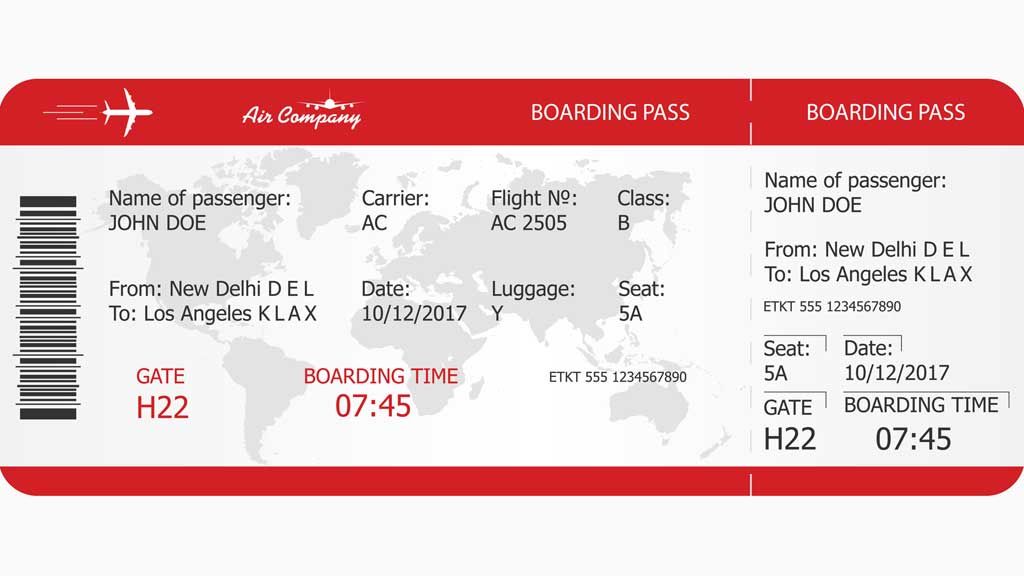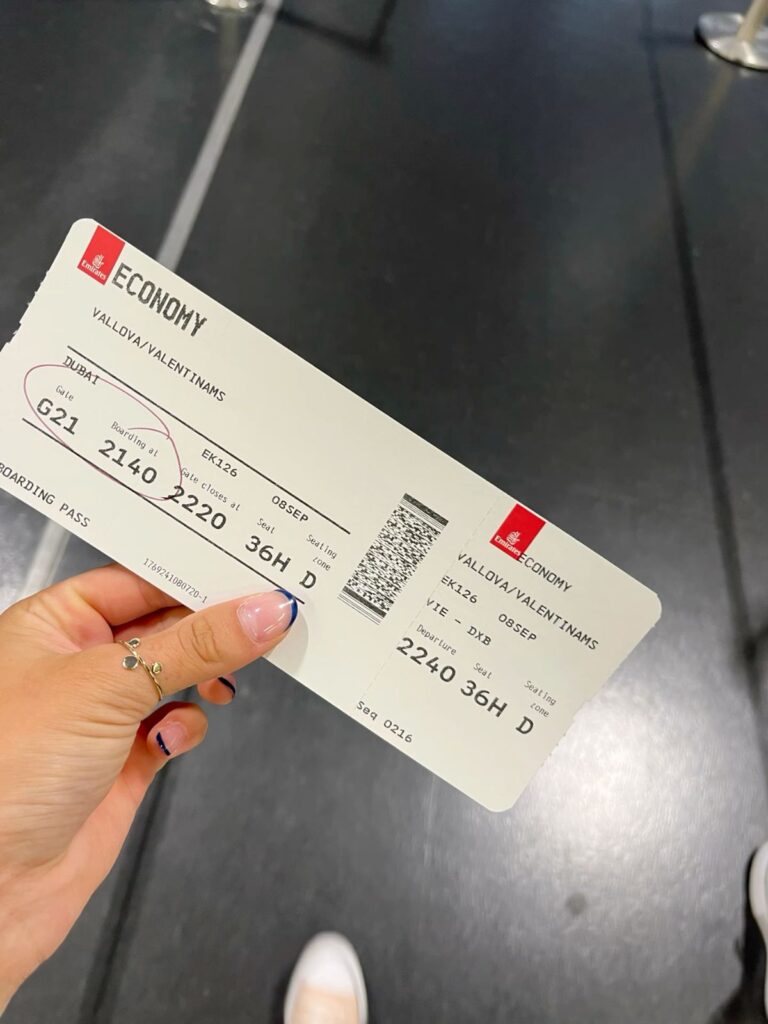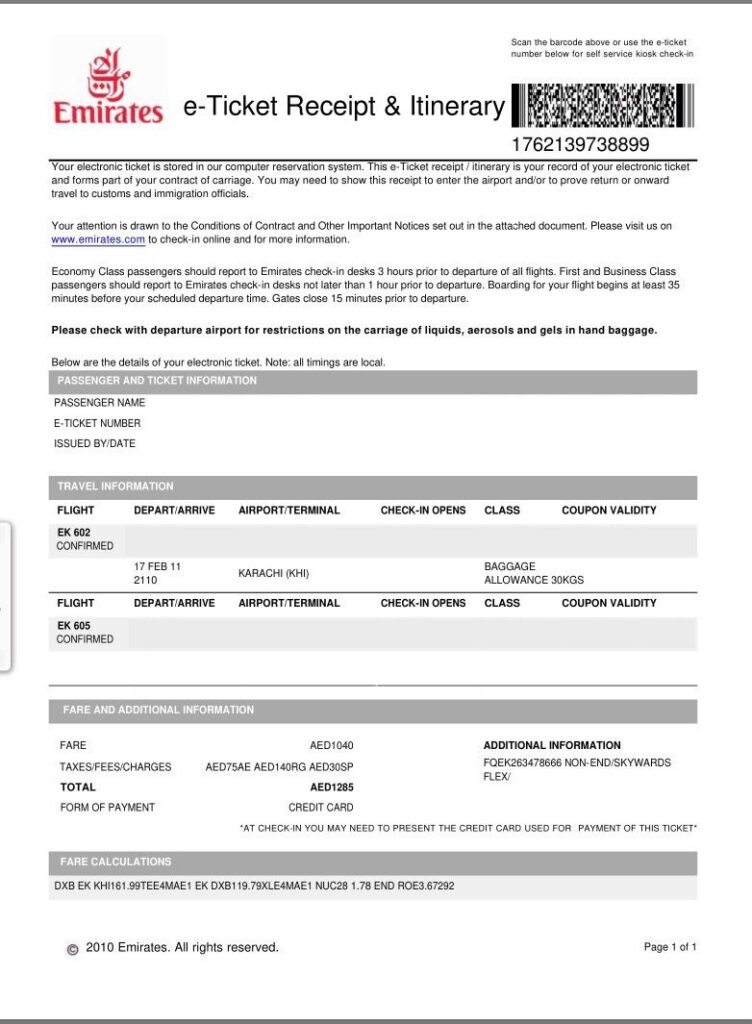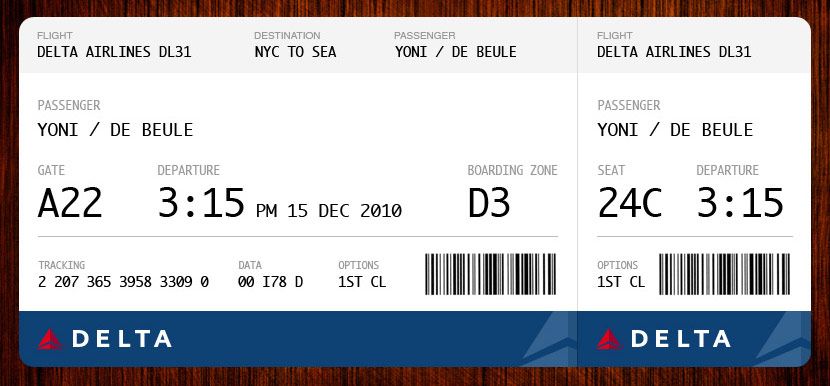Decoding Your Airline Ticket: A Guide to Ticket Numbers, E-Tickets, and More.
Transform your travel confusion into booking confidence with our complete airline ticket guide
🎯 Quick Reference Guide (Save This!)
Need help right now? Here’s what each code means:
- 📧 Confirmation Code (PNR): 6-character booking reference (ABC123)
- 🎫 Ticket Number: 13-digit number for refunds/changes (001-2345678901)
- ✈️ Flight Number: Airline + digits for your specific flight (BA 123)
- 💺 Seat Code: Letter + number for your exact seat (14F)
What is an Airline Ticket Number? (Quick Answer)
An airline ticket number is a unique 13-digit code that identifies your specific flight reservation. It’s different from your booking reference and appears on your e-ticket as “Ticket Number” or “TKT.”
Where to Find Your Airline Ticket Number:
- ✈️ E-ticket confirmation email
- 📱 Airline mobile app booking section
- 🎫 Boarding pass (printed or digital)
- 💻 Airline website “Manage Booking” section
🏨 Got Your Flight Sorted? Don’t Overpay for Hotels!
Now that you understand your ticket, make sure you’re getting the best hotel deals at your destination:
Find Cheap Hotels for Your Trip →
Airline Ticket Number Examples by Airline
Here’s how ticket numbers appear on different airlines:

Your Ticket Number: ETKT 555 1234567890
Location on Boarding Pass:
- Appears on both the left and right sides
- Listed as “ETKT 555 1234567890”
- ETKT stands for “Electronic Ticket”
🔍 Breaking Down This Ticket Number:
Format: ETKT 555 1234567890
- 555 = Air Canada’s airline code
- 1234567890 = Your unique ticket identifier
- ETKT = Electronic Ticket designation
📋 Other Key Details on This Boarding Pass:
- Flight: AC 2505 (Air Canada)
- Route: New Delhi (DEL) → Los Angeles (LAX)
- Date: 10/12/2017
- Seat: 5A
- Gate: H22
- Boarding Time: 07:45
- Class: B (Business Class)
🌍 Popular Hotel Destinations from Our Readers:
Dubai Hotels – Save 50-70% with Smart Booking
- Business Bay: Modern hotels, Dubai Mall access
- Downtown: Near Burj Khalifa, premium locations
- Deira: Budget-friendly, traditional Dubai experience
- Book Dubai Hotels Now →
Singapore Hotels – Business District vs Tourist Areas
- Marina Bay: Luxury hotels, iconic skyline views
- Chinatown: Budget options, cultural immersion
- Orchard Road: Shopping district, mid-range hotels
- Find Singapore Hotels →
Lagos Hotels – Safe Areas with Airport Transfers
- Victoria Island: Business district, secure locations
- Ikoyi: Upscale area, international hotels
- Ikeja: Near airport, convenient for layovers
- Book Lagos Hotels →

What I Can See on This Emirates Boarding Pass
Visible Information:
- ✈️ Flight: EK156 (Emirates)
- 🎫 Class: Economy
- 💺 Seat: 36H D
- 📍 Departure: 2240 (10:40 PM)
- 🏷️ Sequence: 0245
- 👤 Passenger: VALLOVA/VALENTINAMS
❌ Missing: The Ticket Number
Why you might not see it:
- Emirates boarding passes don’t always show ticket numbers
- The ticket number is typically on your e-ticket confirmation
- Some airlines only include it in booking confirmations, not boarding passes
Understanding Your Airline Ticket: Complete Breakdown
In the complex world of air travel, understanding the various components of your airline ticket can be a daunting task. From ticket numbers to e-tickets, flight numbers to booking references, there’s a wealth of information that can leave even seasoned travelers scratching their heads.
What is a Ticket Number?

Your Emirates Ticket Number: 176-2139738899
Location on E-Ticket:
- Right side of the header, below the barcode
- Displayed as: 176-2139738899
🔍 Breaking Down This Ticket Number:
Format: 176-2139738899
- 176 = Emirates airline code
- 2139738899 = Your unique 10-digit ticket identifier
- Total: 13-digit ticket number (including the airline code)
📋 Other Key Information on This E-Ticket:
Flight Details:
- Flight EK 602: CONFIRMED
- Date: 17 FEB 11 at 21:10
- From: Karachi (KHI)
- Baggage: 30KGS allowance
Flight EK 605: Also CONFIRMED (connecting flight)
Fare Information:
- Base Fare: AED1040
- Total: AED1285
- Payment: Credit Card
💡 Important Notes:
This is your official e-ticket – much more detailed than a boarding pass
- Contains complete fare breakdown
- Shows all flight segments
- Includes baggage allowance
- Has full ticket number for customer service
Your ticket number is a unique 13-digit identifier that serves as proof of your purchased flight. It typically appears in this format: 001-2345678901
Where to find it:
- Email confirmation from airline
- Mobile boarding pass
- Physical ticket (if issued)
- Airline app under “My Trips”
Why it matters:
- Required for refunds and exchanges
- Needed for airline customer service calls
- Proof of purchase for insurance claims
- Essential for upgrade requests
E-Ticket vs Physical Ticket
E-Tickets (Electronic Tickets):
- Digital format sent via email
- Environmentally friendly option
- Cannot be lost or stolen
- Instantly delivered upon booking
- Standard for 99% of bookings today
Physical Tickets:
- Rare, mostly for complex itineraries
- Paper document with carbon copies
- Higher risk of loss or damage
- Additional fees may apply
Understanding Confirmation Codes (PNR)
Your Passenger Name Record (PNR) or confirmation code is typically a 6-character alphanumeric code (like ABC123) that links to your entire booking.
Multiple names for the same thing:
- Confirmation code
- Booking reference
- Record locator
- Reservation code
Flight Numbers Explained
Flight numbers follow a specific pattern: Airline Code + Number
Examples:
- BA 123 = British Airways flight 123
- EK 456 = Emirates flight 456
- LH 789 = Lufthansa flight 789
Flight number facts:
- Same number used daily for same route
- Lower numbers often indicate premium routes
- Even numbers typically go east/north
- Odd numbers typically go west/south
Decoding Seat Assignments
Seat codes combine letter + number: 14F
- Number: Row position (1 = front, higher = back)
- Letter: Seat position (A/F = window, C/D = aisle in wide-body)
Seat map basics:
- A-F: Standard wide-body configuration
- A-C: Narrow-body left side
- D-F: Narrow-body right side
- Exit rows: More legroom, restrictions apply
Fare Class and Booking Class
Your ticket shows a fare class (like Y, B, H, Q) that determines:
- Refund eligibility
- Change fees
- Upgrade possibilities
- Frequent flyer mile earnings
- Seat selection options
Common fare classes:
- Y, B, M: Full-fare economy (flexible)
- H, Q, V: Discounted economy (restricted)
- J, C, D: Business class variations
- F, A: First class options
💼 Planning Your Next Business Trip?
Understanding airline codes is just the beginning. For your next business travel:
Premium Flight Options:
- Priority check-in and boarding
- Lounge access included
- Flat-bed seats on long-haul
- Enhanced meal service
Corporate Travel Tips:
- Book Tuesday afternoons for best business rates
- Consider premium economy for 6+ hour flights
- Choose aisle seats for productivity
- Pack carry-on only for efficiency
🎒 Budget Travel Hacks
Smart Booking Strategies:
- Tuesday 3PM Rule: Best time to find deals
- Hidden City Ticketing: Risky but can save 50%+
- Flexible Dates: Save $100-300 by shifting days
- Alternative Airports: Sometimes cheaper than main hubs
Money-Saving Pro Tips:
- Clear browser cookies before booking
- Use incognito mode for price searches
- Book domestic flights 1-3 months ahead
- Book international flights 2-8 months ahead
🚗 Complete Your Travel Planning
Ground Transportation at Your Destination:
Car Rental Tips:
- Book with your airline for package discounts
- Check rental location: airport vs downtown
- Understand fuel policies before signing
- Consider insurance options carefully
Alternative Transportation:
- Airport shuttles and transfers
- Ride-sharing apps (Uber, Bolt)
- Public transportation passes
- Hotel shuttle services
📱 Digital Travel Tools
Essential Apps for Ticket Management:
- Airline Apps: Direct access to boarding passes
- TripIt: Organize all travel confirmations
- App in the Air: Flight tracking and delays
- Google Trips: Comprehensive travel planning
Backup Documentation:
- Screenshot boarding passes
- Email confirmations to yourself
- Save offline copies of tickets
- Share itinerary with emergency contacts
🆘 When Things Go Wrong
Common Ticket Issues:
Name Misspellings:
- Contact airline immediately
- Small errors often fixable for free
- Major changes may require new ticket
Lost Confirmation Codes:
- Check email (including spam folder)
- Log into airline website
- Call airline with ID and flight details
- Visit airport ticket counter
Flight Changes/Cancellations:
- Know your passenger rights
- Document everything with photos
- Ask about compensation eligibility
- Consider travel insurance for future trips
✈️ Airline Code vs Reservation Code: What’s the Difference?
Many travelers confuse airline codes with reservation codes. Here’s the clear breakdown:
Airline Code (2-3 letters):
- Examples: BA (British Airways), EK (Emirates), LH (Lufthansa)
- Purpose: Identifies the airline company
- Where to find: Before flight number (BA 123, EK 456)
- Usage: Flight tracking, airline identification
Reservation Code (6 characters):
- Examples: ABC123, XYZ789, DEF456
- Purpose: Your specific booking reference
- Where to find: Booking confirmation email
- Usage: Check-in, changes, customer service
🎫 What is Ticket Number in Flight? Complete Explanation
Your ticket number is different from all other codes:
Ticket Number Format:
- Length: 13 digits (001-2345678901)
- Structure: Airline code + unique number
- Example: 001-2345678901 (American Airlines ticket)
When You Need Your Ticket Number:
✅ Refund requests – Airlines require this for processing
✅ Insurance claims – Travel insurance needs ticket proof
✅ Frequent flyer credits – Miles posting requires ticket number
✅ Customer service – Airlines verify your purchase
🔢 Is Flight Number Same as Confirmation Number? No!
This confusion costs travelers time and stress. Here’s the truth:
Flight Number:
- Purpose: Identifies specific flight route
- Format: Airline code + numbers (BA 123)
- Changes: Same number used daily for same route
- Example: BA 123 flies London-Dubai every day
Confirmation Number:
- Purpose: Your personal booking reference
- Format: 6-character code (ABC123)
- Unique: Only yours, never repeated
- Example: ABC123 is only for your specific booking
Quick Reference:
- Use flight number for: Flight tracking, airport displays
- Use confirmation number for: Check-in, changes, customer service
🎯 Ready to Book Your Next Adventure?
Now that you’re an airline ticket expert, don’t let expensive bookings drain your travel budget:
Complete Travel Booking Strategy:
Why Smart Travelers Use Our Recommended Platform:
✅ Compares 1,000+ airlines – Never miss a deal ✅ Price alerts included – Get notified of drops
✅ Flexible date search – Find cheapest travel days ✅ No hidden fees – What you see is what you pay ✅ 24/7 customer support – Help when you need it
Don’t Forget Your Hotel:
- Price matching guarantees
- Free cancellation on most bookings
- Verified guest reviews
- Mobile check-in available
📚 Related Travel Guides
Master every aspect of your travel planning:
- Best Flight Booking Sites 2025 – Compare all major platforms
- Cheapest Flights to Dubai 2025 – Route-specific savings
- Emirates vs Qatar Airways – Premium airline comparison
- JNB to Dubai Flights – South Africa routing guide
💡 Bookmark this guide – I update it monthly with new airline policies, booking tips, and industry changes!
Still have questions about your airline ticket? Drop a comment below and I’ll help you decode any confusing codes or policies!

On this boarding pass, you can see:
- ✈️ Flight Number: DL31 (Delta Airlines flight 31)
- 🎫 Confirmation/Record Locator: The barcode contains booking reference data
- 📍 Gate: A22
- 💺 Seat: 24C
- 🕒 Departure: 3:15 PM
- 📅 Date: 15 DEC 2010
What’s Missing: The Ticket Number
- Ticket numbers are 13-digit codes (like 006-1234567890 for Delta)
- They don’t typically appear on boarding passes
- They’re found on your e-ticket confirmation email








